
India's Green Energy Capacity Skyrockets 138% in a Decade: FY14 to FY23

 Over the past ten years, India has made remarkable strides in the realm of green energy, witnessing a notable shift as renewable power now constitutes 43% of the total installed power capacity for 2022-23. This signifies a substantial rise from the 31% reported in 2014-15, as per data provided by the Central Electricity Authority. The overall installed capacity for renewable energy has surged to 180 gigawatts (GW) in 2023, a significant increase from the 75.5 GW recorded in 2014. Noteworthy is the decline in the share of fossil fuel-based power, dropping from 69% in 2014-15 to the current 57%.
Over the past ten years, India has made remarkable strides in the realm of green energy, witnessing a notable shift as renewable power now constitutes 43% of the total installed power capacity for 2022-23. This signifies a substantial rise from the 31% reported in 2014-15, as per data provided by the Central Electricity Authority. The overall installed capacity for renewable energy has surged to 180 gigawatts (GW) in 2023, a significant increase from the 75.5 GW recorded in 2014. Noteworthy is the decline in the share of fossil fuel-based power, dropping from 69% in 2014-15 to the current 57%.
The government has set an ambitious target to triple its contribution to renewable energy, with a goal of reaching 500 gigawatts (GW) by 2030. The plan involves annually adding 50 GW of renewable energy capacity, and entities like the Solar Energy Corporation of India (SECI), SJVN, and NHPC have actively awarded contracts for expanding solar, wind, and hydro capacities in recent months to support this objective.
Recognizing the significance of a robust distribution network, the government is addressing the slow progress in expanding transmission lines. The effectiveness of the installed renewable energy capacity relies on this infrastructure. From 2017 to March 31, 2022, the interregional transmission capacity increased to 37,200 megawatts (MW). As of March 2023, the country's inter-regional transmission capacity has reached 112,250 MW, according to data from the Central Electricity Authority's annual report. In the fiscal year 2022-23, India's cumulative transmission lines extended to 471,341 circuit kilometers (ckm), a substantial rise from the 313,437 ckm recorded in 2014-15. For the current financial year, the government aims to enhance the transmission network by adding 16,602 ckm, surpassing the 14,625 ckm added in the previous fiscal year (FY23).